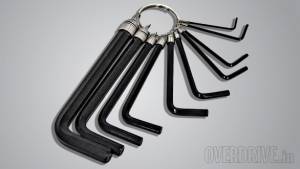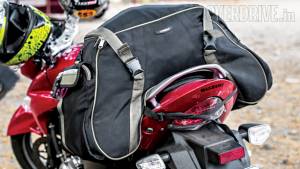Touring test: Royal Enfield Continental GT vs Suzuki Inazuma 250 vs KTM 390 Duke
It's fifteen and a half hours after it started and it has only just gotten over. I've left the road but it hasn't left me yet. I can still feel the unending vibration, sometimes gentle, sometimes violent shaking my hands and feet as if I'm still riding. Some ten floors below, the KTM is still ticking away as it cools. I'm sure the Suzuki Inazuma in Alan's garage and the Royal Enfield Continental GT at Halley's are also cooling off gently at this very moment.
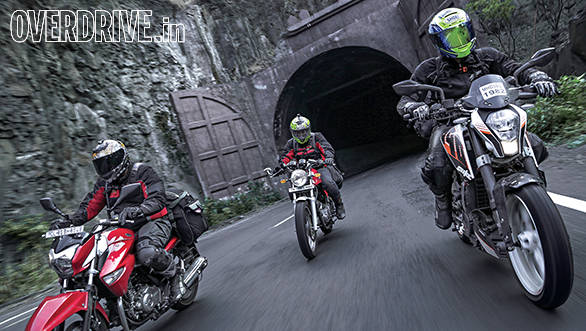
We have all just returned from a trip to Coimbatore on these bikes. That is a 1400km ride each way and while we were at Coimbatore, we took them out on track for a spot of fun. Well fun, and because Halley and Alan wanted to go to the TWO Track School.
At this point you might ask why we did this. Well, first of all, because it was there. The highway from Mumbai to Bangalore and then on to Coimbatore is empty and in great shape so the ride is long but relatively simple. More importantly, we wanted to explore the idea of touring on bikes that weren't really meant for the open road. All of these three should be expected to have trouble on the highway in one way or another. The Suzuki Inazuma has the right temperament but lacks outright power as well as a reasonable price (now corrected). The Royal Enfield Continental GT has the best engine from the manufacturer's current lineup as well as unprecedented dynamic ability, but its ergonomics are suited for brief intra-brew sprints rather than long extended highway jaunts. Finally, the KTM has the right-est engine of this lot perhaps, but it is rock hard in both the seat and ride quality department and that's a major stumbling block. And just so we are clear, the Honda to us hits the sweet spot in terms of price, ability and aptitude for the open road.
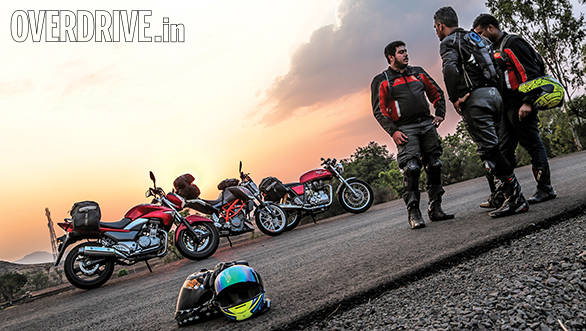
But there is an underlying philosophical problem that we are also trying to poke and prod here. Current day motorcycles have become super specialists. A supersport is for track and racing and an adventure tourer is for extended distances and light off-roading and so forth. But more importantly, there seems to be a widely held belief that if you have a supersport, you cannot tour. Or, closer home, that India has no real touring bikes and so forth.
Is this really true? We rode 2700km on each motorcycle to find out. We crossed towns and villages, highways and byways, finished six lane roads and diversion-filled to-be six lanes (and we rode the racetrack as well). This mammoth effort was in the pursuit of our scientific curiosity to answer the question whether your motorcycle enables you or the type of motorcycle you have actually gets in your way. And of course, also because this was going to be a fun ride.
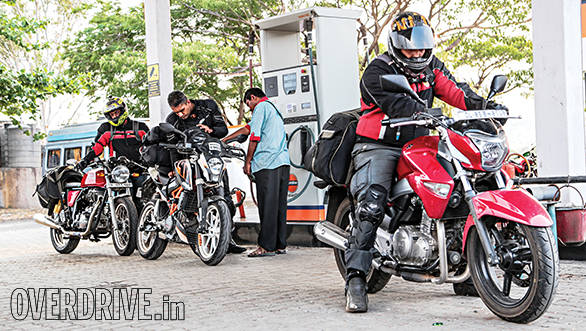 The KTM surprised us with the biggest tank range while the Zuma was, clearly, the most spacious, comfy motorcycle of this trio
The KTM surprised us with the biggest tank range while the Zuma was, clearly, the most spacious, comfy motorcycle of this trio
I started on the KTM. The 390 easily holds as much as 130kmph for hours though you have to be willing to get past the mental block of having a bike do 7,000rpm for that period. If you are unwilling to have an engine rev that high, 105-110kmph is actually quite peaceful. The engine turns over at 5-6000rpm, or halfway between idle and redline. At this speed, the KTM feels peaceful and opening the throttle produces strong acceleration which means passing even fast highway traffic requires only the twist of the wrist. Additionally, we discovered that 105-115kmph is a good cruising speed because the 390 also returns between 30 and 33kmpl which, astonishingly enough, gives it the best tank range of the trio despite its tiny 10.5litre tank.
The KTM does have a stiff ride though and that makes riding bumpy highways more work than it needs to be. Reducing the preload one or two notches helps somewhat. The hard seat, another surprise, isn't as much of a pain in the arse as you think. It does take a bit of getting used to the feel of it but six hours later you discover that you're still not subjected to the ache and pain you were expecting and it was only about eight hours in that I began to squirm about. An eight hour seat range, I think, is something you can live with.
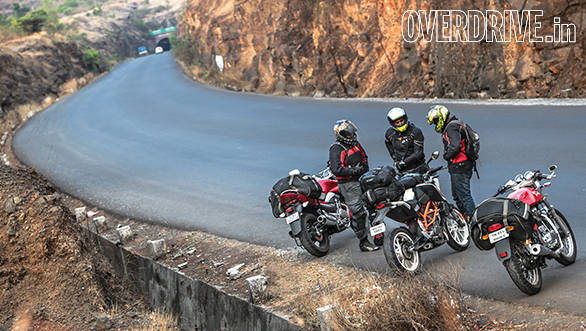 It does look like we stopped a lot but we actually didn't
It does look like we stopped a lot but we actually didn't
It is the squirming around that is actually the biggest problem on the 390. The KTM, as we have noted earlier, isn't very spacious and that is a genuine problem. I caught up with another rider on a 390 by chance and we rode together for about 500km. He was using saddlebags - as opposed to my mid-back high set of pillion-seat mounted luggage - but the stepped seat didn't allow him significantly more space than I had.
The point is that you have to be very careful when mounting luggage on the KTM. Bungee points are few and far between and the pillion pad isn't very spacious to begin with. Space is at such a premium that in the eleventh hour of the ride, you have no option but to start standing up on the pegs as a way to relieve your bum.
The other issue we have been asked about often is the windblast. Personally, I don't think it is an issue up to about 120-125kmph but after that the KTM gets windy. The KTM tall screen (Rs 2,550) does help but only a tiny little bit. I naturally hunch in the saddle (a curved back is better to absorb shocks with and possibly more aerodynamic as well) but if you sit up straight, the tall screen shoves a rather well-aimed blast of air right up the helmet which gets uncomfortable fast. I've heard Yamaha Fazer screens can be hacked into effective, large windshields for the 390 so if you're serious about big miles and big speeds maybe that's where you should be looking for a solution.
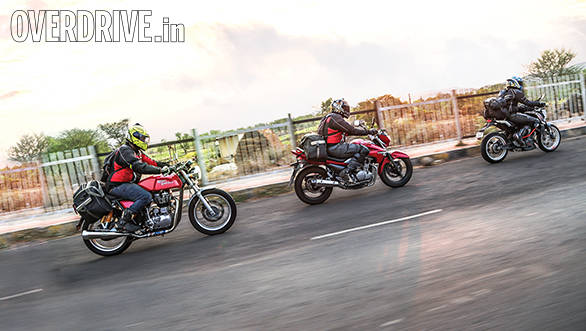 Despite characteristics that should render them unfit for the highway, the three machines are fun on a long, hot ride
Despite characteristics that should render them unfit for the highway, the three machines are fun on a long, hot ride
Back to the positives, the KTM has such little bar or peg vibes that you never get numb hands or feet even after a 300km stint (which is the maximum you can stretch the tank range to in a pinch). At night, the stock head lamp is also pretty decent though I did wish that flipping to high beam would leave the low beam filament on for a greater spread of light. It certainly isn't good enough to hold the same speeds you would during the day, it must be said.
The KTM also offers standard ABS and a sharp responsive chassis and given how unpredictable our highways can be, I did find it reassuring to know that I could brake to a hard stop regardless of road condition. Or change direction quickly to avoid the idiot ambling across the road or a cow that decided to stop right in the middle of the highway.
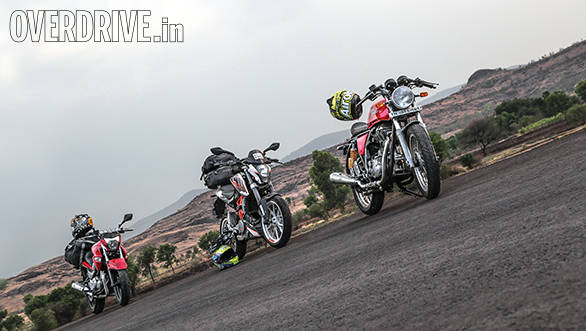
When you jump off the KTM and onto either of the other two machines, you spend the first half an hour just missing all that power and torque, which is but natural. But if it is the Suzuki Inazuma you've hopped on to, you'll also emphatically notice how much smoother the Suzuki 249cc twin-cylinder engine is. It's one of the things you will absolutely love about the Suzuki. It is, in many ways, the complete antithesis of the KTM. It has pronounced strengths in precisely the same areas where the KTM is weak.
For example, the Suzuki, for a 250, is a very large motorcycle. Which means it has a long seat and thankfully, a very comfortable seat. Halley who rode the Suzuki the most, noted, "The seat is so much softer and comfortable when compared to either of the other bikes, especially the KTM. Also, there is so much more space. I could even lean back and ride, or hunch forward, slide forward or back. I had options." The space also means that mounting luggage is easier. Halley adds, "I found lots of mounting points where I could anchor my luggage easily on the 'Zuma and once mounted, the bags stayed secure and didn't encroach into my space at any point. The Inazuma's natural ergonomics and comfort makes this less critical overall though."
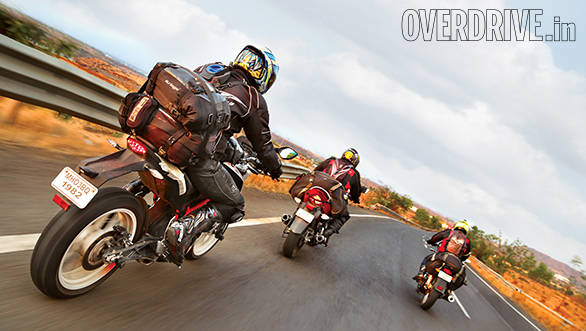
The Inazuma is also noticeably softer sprung and the ride quality is astonishingly, marvelously plush. Where you notice the KTM rider being jiggled about by bad roads - especially on Maharashtra highways - the Inazuma is calm and poised. From the other bikes you can actually see the road pummeling the wheels but almost nothing gets through to the rider who seems oddly unmoving amidst a lot of suspension activity.
The 'Zuma is a consummate tourer, it is extremely comfy, ride quality is sorted, handling is responsive enough and the refinement and silence of the parallel twin is just amazing. What the Inazuma lacks really is grunt. Holding anything over 105kmph feels like work though the engine never loses its grip on overall refinement. At these speeds, passing faster traffic is naturally slower than the KTM and yes, if the 390 rider lights the wick and decides to up the pace, the Inazuma rider has no option but to wait for the KTM to stop and take a break. Halley says, "I initially thought the KTM's small tank and riding at triple digit speeds would mean it would stop more often and that would even out the difference in pace. But it just doesn't happen. The Inazuma only asserts its superior fuel tank capacity and range if you're going to hold 80-90kmph and that, clearly, isn't something we were planning to do this time."
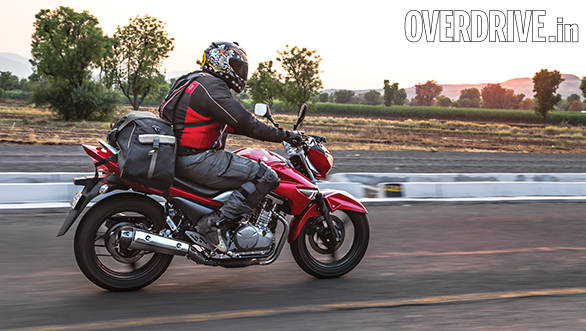 The Zuma only needs a little more power to become a great highway machine
The Zuma only needs a little more power to become a great highway machine
Once the light fades, the Inazuma has the most trouble. It isn't as if its head light is extraordinarily weak, but the other two bikes have better headlights than the 'Zuma. Our test bike's head light was also adjusted to light up Saturn more than the road, which didn't help matters. Maybe that's why Alan took the 'Zuma from Halley on the return leg and stopped in at Pune, cutting out about two and half hours of riding in the night. Alan says, "Yes, in the Suzuki not only was the headlight pointed up, it also had the least focused headlight beam of the three. It left the rider no choice but to follow the Continental GT." Halley used this to his advantage, "Since the Suzuki could keep up with the Continental GT in cruising speeds, I had let Alan and the GT ride ahead of me and light up the highway for me."
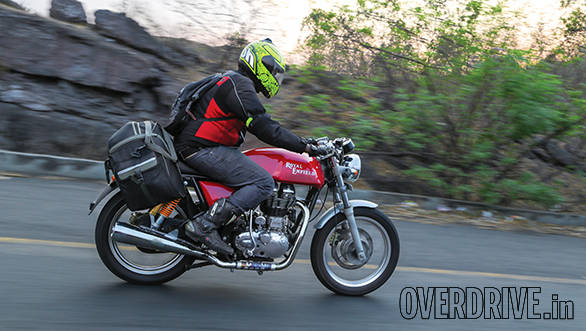 The GT looks odd with its skewed luggage but the bag never moved and it worked out rather well
The GT looks odd with its skewed luggage but the bag never moved and it worked out rather well
Is it just that Alan couldn't handle the Continental GT after fourteen hours in the saddle? "Partly. The Continental was a shaking, vibrating torture over 110kmph. But that being said, I just rode the Continental GT for 3,500km on the Tour Of Bhutan and I didn't find that a hassle at all. Of course, this road trip and Bhutan are very different in terms of terrain and feel. In Bhutan, the GT never saw such high speeds because of the twisty roads and it shook me up a lot less. The Coimbatore ride is much harder for the GT because it's straight and empty and cruising speeds are consistently and relentlessly higher."
That really does describe the biggest weakness in the Continental GT - its engine. Royal Enfield did get a little more torque and power out of the bored-out 535cc engine but the vibration from the big single is still the biggest issue with riding the GT for long hours. They get pretty serious by 4,000rpm and by 5,000rpm, there are enough vibes in the handlebar for you to know that holding on is going to be a task and that at 110kmph plus, it isn't sustainable.
Halley says, "As usual we had planned to shoot in the middle of this long ride and that created a situation where we had no option but to ride about 125km as close to flat-out as we dared racing the sunset to a location. I, however, had to do this on the GT. We were holding about 115-120kmph on the speedo and I can tell that when we finally stopped, I could feel that buzzy numbness that comes from bar vibes after a ride. Something that you can't help but notice especially because neither the KTM nor the 'Zuma have anything approaching that level of vibration."
But the Continental GT is extremely evocative if you're willing to go a bit slower on the highway. At 60-80kmph the vibration is relatively minor and the bike seems to enjoy this pace the most. The bike may be inspired by the seventies but in terms of speed, it likes the eighties. At these speeds, the GT has enough grunt to get past traffic easily, and economy and range are also pretty good.
The ergonomics of the motorcycle - the canted forward riding position of the cafe racer was much less of a hassle than we imagined. Alan says, "The GT's riding position requires a little bit of getting used to but it is not as uncomfortable as you think. Grip the tank with your legs and keep your body weight off your wrists and it's actually quite a comfortable perch. The suspension while on the stiffer side is quite refined and does manage to isolate you from most of the rough stuff."
On the other hand, the handling is actually thoroughly enjoyable. The Karnataka stretch has some really lovely wide sweeping turns that can be taken at speed and here the GT is quite a bit of fun. Alan says, "I really liked the way the GT handled, both on the track and on the twisty mountain roads of Bhutan. It loves corners and is by far the best handling motorcycle in the Royal Enfield stables." Even the ride quality has come quite a way forward and the GT handled the bumpy Maharashtra highways in reasonable comfort.
One of the two other things we noted was that the luggage mounted quite securely to the single seat after we taped up the hump with masking tape and then mounted the bags on top. It doesn't look ideal but it works like a charm. The second is that the bar-end mirrors can come loose and there is a remote chance that they could rotate forward and block the front brake or clutch levers - so check the Allen bolt for tightness before you head out. We are thorough, so we also checked Alan's bolts while we were at it.
Overall the GT makes a decent, if unlikely, highway machine. In this company you do notice that it is the least refined of the three in possibly every department whether it's the engine's NVH, precision of the chassis corners or control over its suspension and wheels. It does have extremely effective brakes as well as the best head lamp on test. As in, we wouldn't hesitate for even a moment if the opportunity for another extended highway ride presented itself.
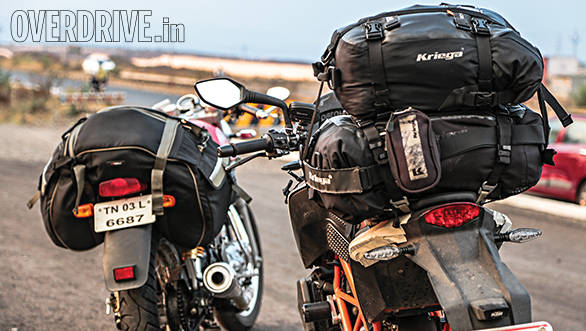
When we rode back into Mumbai after four days out on the highway plus two on the track, all three of us were less tired than we thought and pretty kicked about the 2700km we put over the four days of highway riding.
That really is the point of the story. All three machines have pronounced characteristics that should prevent them from being great at highway work. But they all work well enough for a long, hot ride to be fun.
By extension, the motorcycle in your garage should be able to do it as well. So stop dreaming about heading out and start living that dream. Get the bike serviced, plan a route and just go. That's what motorcycles are for.
Some really great gear that we found useful along the way:-
Luggage -
Tools -
Gear -
Starts Rs 2,52,928
373cc
6-Speed
43.50
37.00
25.00 Kmpl
Starts Rs 1,64,143
250cc
6-Speed
26.50
22.90
-NA-
Starts Rs 1,02,700
149cc
5-Speed
12.40
13.60
-NA-
Starts Rs 1,43,680
249cc
5-Speed
20.90
20.00
43 Kmpl
Related Stories
Top Stories
Latest Videos
Most Popular
- Upcoming Mahindra XUV 3XO: All you need to know
- New Suzuki Swift spotted testing
- Budget Sportbike Showdown: Kawasaki Ninja 500 vs Aprilia RS 457 vs Yamaha YZF-R3
- Nissan Magnite EZ-Shift review - is the AMT any good?
- 2024 Hyundai Creta vs Toyota Urban Cruiser Hyryder vs Skoda Kushaq comparison review - the hype is real?
